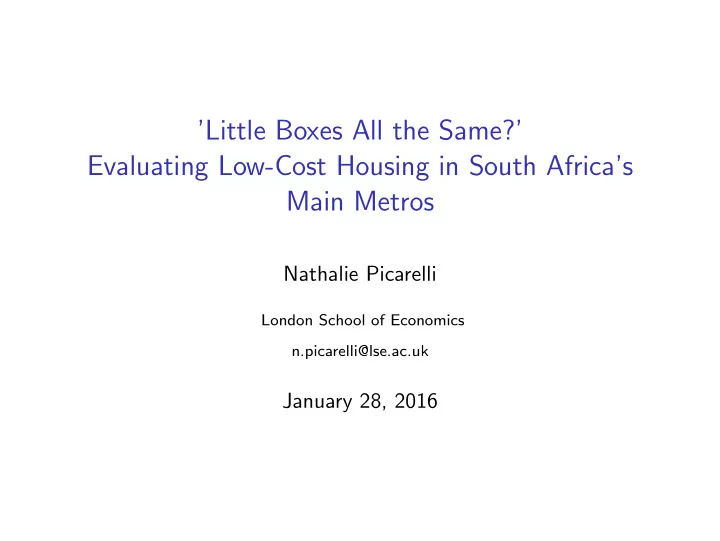

’Little Boxes All the Same?’ Evaluating Low-Cost Housing in South Africa’s Main Metros Nathalie Picarelli London School of Economics n.picarelli@lse.ac.uk January 28, 2016
Challenges of Urbanization in Developing Countries Rapid urbanization in developing countries= proliferation of slums at the peripheries of cities. ◮ In 2014, almost 1/4 of urban population lived in slums. ◮ Sub-Saharan Africa (SSA) has the largest share of slum population in the world (199.5 million in 2015), growing at 4.5 percent per year. ◮ Not only a temporary phenomenon [Marx et al. 2013],but poverty traps.
Challenges of Urbanization in Developing Countries Housing policies have become cornerstones of urban and development policy. Success depends on allowing the poor to benefit from urbanicity [Brueckner and Lall 2015; Glaeser 2011] � = low-cost projects at cities peripheries, poor materials and poor servicing. Benefits of relocating may well be overcome by its costs, i.e. increased commuting and services costs, loss of social networks, poor employment opportunities in the new areas = Low or zero social returns [Barnhardt et al.2015]. Lit.
South Africa Same challenges of other urban areas in SSA: ◮ In 2014, 1/4 of urban population lived in slums. ◮ High levels of unemployment, but small informal sector (30 ◮ Large commuting times and costs (90min daily on avg.2013). ◮ High levels of inequality ◮ PLUS Dysfunctional urban structures = Heritage of apartheid planning. ◮ Spatial dislocation between where the poor live and employment is located [Banerjee et al 2008]
Housing Policy RDP Housing since 1994 One-off capital subsidy to obtain first house - 90% used to finance the construction of free standing houses in greenfield developments .The house is then transferred to the qualifying beneficiary on an ownership basis. Results: ◮ 2.8 million dwellings in 2014 ◮ 24% of the total formal housing stock ◮ From 5.5% of HHs in RDP in 2002 to 9.4% in 2009 and 13.5% in 2013.
This paper Objective: Estimate the causal effect of this large public housing program on labour market participation, unemployment and basic welfare indicators of the programs recipients accross SAs 6 main metropolitan areas. Data: 3 waves of panel household data [2008-2010-2012], Household Level analysis (3500 HH) Research Design: Local Average Treatment Effect (LATE) through a fuzzy regression discontinuity design (RDD) that exploits the arbitrary eligibility cutoff of the policy at a certain income threshold.
Overview 1. Policy Setting 2. Data 3. Empirical Strategy 4. Results 5. Policy Implications
DETAILS OF POLICY (1) National Housing Subsidy Scheme (or RDP): ◮ Developed in 1994 to redress housing inequality left by Apartheid ◮ Basic Eligibility Criteria: 1. South African or permanent Resident 2. 18+ years 3. Married or living with partner or have financial dependents 4. First time owner 5. Never have received subsidy before
DETAILS OF POLICY (2)
DETAILS OF POLICY (3) Phase 1 Form at the provincial or municipal housing department, + proof of qualification. National Housing Subsidy Database (NHSDB) - keeps records of all subsidy applicants across the country. Recorded against ID. Phase 2 Allocated to RDP waiting list. Allocation is made in date order of registration. In 2009 the avg.time in the waiting list was 5 years (GHS) and 13.5 percent HHs had at least one member on a demand database. Phase 3 Eligibility criteria are re-assessed after successful allocation to a project. If still compliant, households are given a property (problem with the deed).
DATA First 3 waves (2008, 2010, and 2012) of the National Income Dynamics Study (NIDS) panel, conducted by Southern Africa Labour and Development Research Unit (SALDRU) at the University of Cape Town. Final Sample Size Households 3542 Individuals 8825 RDP % 9.13
DATA Mean Std. Dev. N II. Households Socio-Demographics Female Head 0.24 0.43 3,542 3,539 Age Head 37.42 15.22 3,542 Household Size 3.46 2.34 Receives Government Grant 0.38 0.48 3,529 III. Residential Characteristics (Households ) 0.11 0.32 3,020 No Refuse Collection 0.87 0.34 2,986 Access to Electricity 0.25 0.43 3,542 Informal Dwelling (large definition) Common to have thefts in neihborhood 0.51 0.49 2,998 Time taken to nearest train by foot (wave 1) 34.42 33.77 516 10.26 8.83 894 Time taken to nearest mini taxi by foot (wave 1) 25.70 16.18 3,542 Average Distance to CBD (km) 123.05 77.95 3,542 Average Distance to CBD (min. by mode of transport) Average Distance to Main Employment Nodes(km) 27.16 15.15 3,542
Empirical Strategy ◮ Identification ID ◮ Probability of treatment at cutoff Prob ◮ McCrary density test of assignment variable MC ◮ Local Polynomial density test Poly ◮ Smoothness of covariates at cutoff Covs ◮ Reduced Forms RF ◮ First Stages FS
Discontinuity Results on Labour Supply (1)
Discontinuity Results on Labour Supply (2)
Discontinuity Results on Welfare Indices
Discontinuity Results on Distances
Results on Household Composition
WHAT IS HAPPENING? ◮ Household re-composition ◮ Higher labour supply cost ◮ Loss of Social Network ◮ Is it all due to spatial mismatch?
Gauteng Map 1
Main Problems with RDP Policy Today 1. Financial considerations ◮ Despite LARGE investments SA cities are still on top in terms of av. daily commuting trips, costs and time with respect to other cities in SSA ◮ Est. housing backlog: 2 Million dwellings ◮ Est. cost: R800-billion until 2020 (FFC 2012) ◮ Transport subsidies are even higher than housing subsidies! ◮ In country where majority uses: MINIBUS TAXI (71% of commuters) - receives only 1% of public transport subsidies [Kerr 2015] 2. Social/Politicalconsiderations ◮ Social perceptions: ”It’s a house that was given for free and it gives value to our lives as well as dignity ”It’s a free house given to the poor by Mandela”
Conclusions and Policy Implications 1. Problems with policy implementation per se (municipality role, waiting list, materials etc.) 2. Issue with ’subsidizing’ housing and transport BUT NOT addressing spatial layout (low densities, ghettoization of the poor...) 3. What POLICIES? ◮ CONNECTIVITY-ACCESS policies ◮ Housing - SS: Rent vs ownership, land zoning regulations ◮ Housing - DS: Finance, upgrading ◮ Densification policies
Appendix
back
back
back
back
back
back
Recommend
More recommend